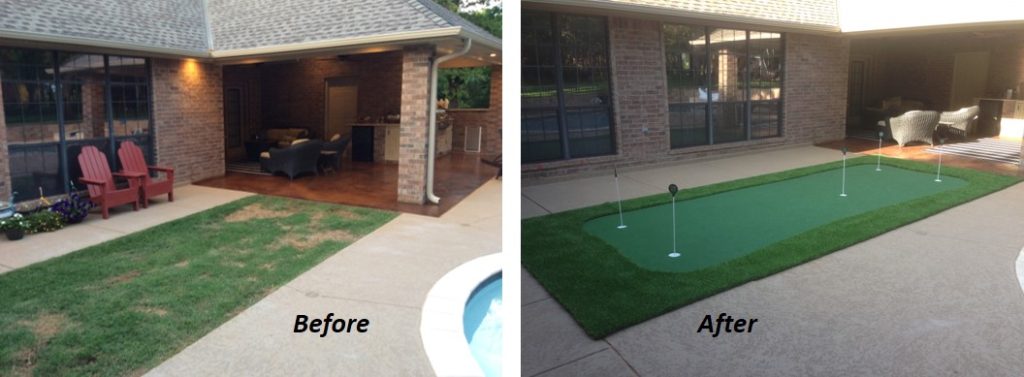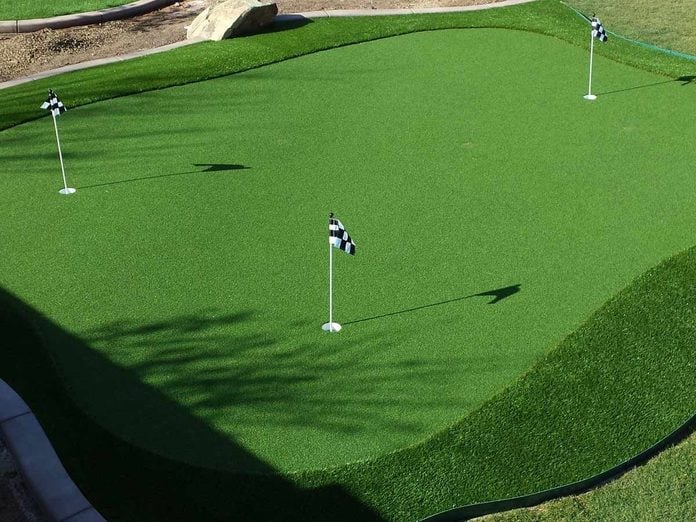Artificial grass putting greens are a fantastic addition to any home, providing a convenient and low-maintenance way to practice your golf game. In this article, we’ll discuss everything you need to know about installing an artificial grass putting green, including the benefits, the installation process, and how to maintain your green for optimal performance.
Benefits of Artificial Grass Putting Greens
There are several benefits to installing an artificial grass putting green in your home.First and foremost, By installing artificial turf of any kind, you are able to increase the value of your home.Projects like this, that may have an upfront cost, can add value to your home in the long run. As you consider the future of your homeownership in that property, think about the value you can add with an artificial turf putting green.And artificial grass is incredibly low-maintenance. Unlike natural grass, which requires regular watering, mowing, and fertilizing, artificial grass requires minimal upkeep. Additionally, artificial grass is more durable than natural grass, making it ideal for high-traffic areas like putting greens. Finally,Artificial turf looks great all year long, without all the hard work. A putting green can make a great addition to just about any yard, and it doesn’t need hours of care to continue looking beautiful.

Installation Process:
Installing an artificial grass putting green is a relatively straightforward process, but it does require some preparation and planning. Here’s a step-by-step guide to installing your own artificial grass putting green:
1.Excavating Your Yard Area
A professional putting green installation team will want to mark the dimensions of your putting green course using landscapers paint before the ground excavation begins. Make sure they include some space in their design outline for your turf’s fringe, and determine whether it will be included in the overall design of the greens. As installers prepare to excavate your yard, they will remove all organic materials. Natural grass, soil, or sod will be removed from the ground to a depth of about 6 feet.
2.Clean the Ground
Use a rake or shovel to level out the synthetic putting green site and remove any remaining dirt clods. This will help create a clean and debris-free surface for the artificial turf.

3.Install the base layer
After the ground is prepared, you’ll need to install a base layer of crushed stone or gravel. This will provide a stable foundation for your artificial grass putting green.
4.Cup Placement
It takes some skills to install golf cups. A professional installation team will want to arrange the cup sleeves in their desired positions first. Next, remove gravel from the area so that the sleeve sits as flush with the surface level as possible. Slowly compact the area until the sleeve is level with the final grade. After that, gently fill any surrounding areas with gravel, water, and compact it down. Your cups should sit in their sleeves with the lip about ¼” above its base.

5.Install the putting grass
Once the area is compacted and the putting green base is prepped, you can now move on to the installation. While it seems that the hard part is over, there are still precautions to take to maintain the integrity of your putting green.
You’ll have a longer fringe grass and the putting green material to contour and cut to size. Cut the turf and shape it to the area before seaming with adhesive. The turf is then stretched and secured to the base with nails every 2 inches on the border, and every 2 feet throughout the surface.
6.Seaming with Glue and Tape
When seaming artificial turf putting greens, a professional installation team has several options. Seaming with glue and tape can be labor-intensive, but this method is sturdy. Also, seaming with glue and tape is a commonly used method for putting green installation because it’s dense and short. Other unsightly items like staples and nails may stick out from the turf’s surface.
7.Add infill
Finally, you’ll need to add infill to the artificial grass. Infill helps to weigh down the grass and provide a more realistic playing surface. There are several types of infill available, so be sure to choose one that is suitable for your putting green.
Conclusion:
Artificial grass putting greens are a fantastic addition to any home, providing a convenient and low-maintenance way to practice your golf game. By following the steps outlined in this article, you can install your own artificial grass putting green and enjoy all the benefits it has to offer.



